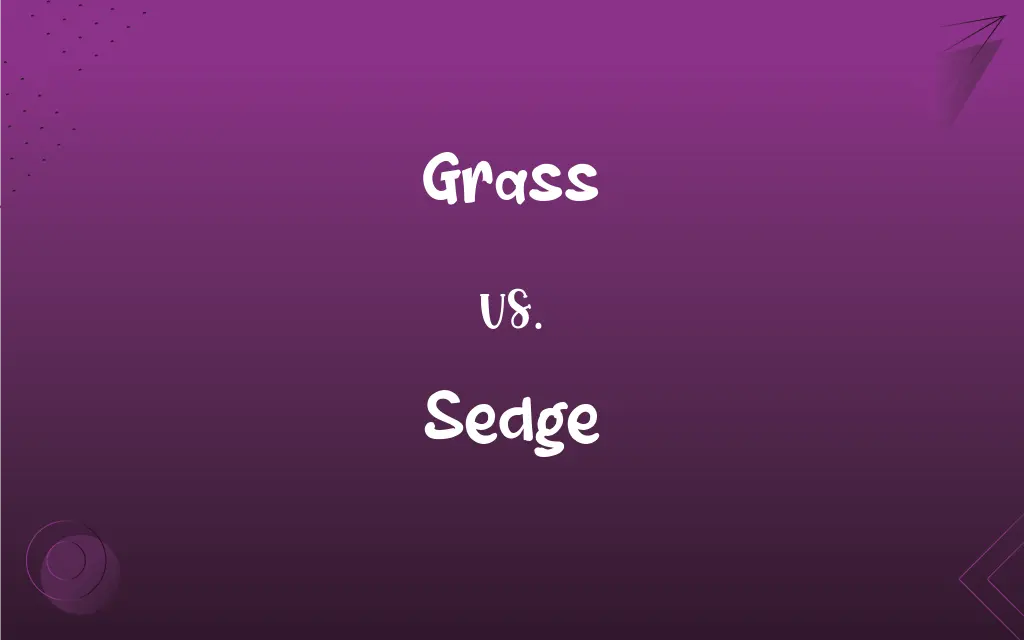Grass vs. Sedge: What's the Difference?
Edited by Harlon Moss || By Janet White || Published on March 13, 2024
Grass is a family of monocotyledonous plants with jointed stems and narrow leaves, while sedge is a family of grass-like plants with solid, triangular stems and leaves arranged in three ranks.

Key Differences
Grass and sedge are two distinct families of plants that are often confused due to their similar appearance. Grasses, belonging to the family Poaceae, are characterized by their hollow, round stems and leaves that grow in two ranks. Sedges, on the other hand, are members of the family Cyperaceae. They are easily distinguished by their solid, triangular stems and leaves that grow in three ranks. Sedges are often found in wetter habitats like marshes and edges of water bodies.
One of the key differences between grass and sedge is their stem structure. The round, hollow stems of grasses contrast with the solid, triangular stems of sedges. This difference is a crucial identification feature for distinguishing between the two. Additionally, the arrangement of leaves in grasses is in two ranks, whereas in sedges, the leaves are arranged in three ranks, giving them a more tufted appearance.
Both grasses and sedges are important components of ecosystems, providing habitat and food for wildlife. However, their uses by humans differ, with grasses being more commonly used for food, fodder, and lawns, while sedges are often used for ornamental purposes and in wetland restoration projects. Understanding the differences between grass and sedge is important for proper identification and management in both natural and cultivated environments.
Comparison Chart
Stem Shape
Hollow and round
Solid and triangular
Leaf Arrangement
Leaves grow in two ranks
Leaves grow in three ranks
ADVERTISEMENT
Habitat
Meadows, fields, lawns
Marshes, wetlands
Root System
Fibrous
Rhizomatous
Uses
Food, fodder, lawns
Ornamental, soil stabilization
Grass and Sedge Definitions
Grass
A groundcover plant used in lawns and gardens.
He mowed the grass every weekend to keep the lawn neat.
Sedge
A type of plant used in ornamental gardens and for soil stabilization.
She planted sedge along the garden path for a natural look.
ADVERTISEMENT
Grass
A term for various species of plants in the Poaceae family.
Wheat and rice are important types of grass used for human consumption.
Sedge
A plant that thrives in moist environments.
The sedge thrived in the marshy area of the nature reserve.
Grass
A family of monocotyledonous plants with jointed stems and narrow leaves.
The grass in the field swayed gently in the breeze.
Sedge
A family of grass-like plants with solid, triangular stems.
The sedge by the pond provided a habitat for frogs and insects.
Grass
Plants with slender leaves and hollow stems, often used as fodder.
Cows grazed on the lush green grass.
Sedge
Plants with three-ranked leaves and often found in wet areas.
The wetland was dominated by various species of sedge.
Grass
A plant that is common in fields and meadows.
The children played in the tall grass near the river.
Sedge
A term for species in the Cyperaceae family.
Carex is a large genus within the sedge family.
Grass
A member of the grass family.
Sedge
Any of numerous grasslike plants of the family Cyperaceae, characteristically having solid three-sided stems, leaves arranged in three rows, and spikelets of inconspicuous flowers.
Grass
The members of the grass family considered as a group.
FAQs
Where are sedges commonly found?
Sedges are commonly found in wetter habitats like marshes and edges of water bodies.
Are sedges used for food like grasses?
Sedges are less commonly used for food compared to grasses.
What is the importance of grasses in agriculture?
Grasses are important in agriculture as they are used as crops (like wheat and rice) and for animal fodder.
What is the main structural difference between grass and sedge?
Grasses have hollow, round stems, while sedges have solid, triangular stems.
Do sedges have flowers?
Yes, sedges do have flowers, but they are usually small and not very conspicuous.
What role do sedges play in ecosystems?
Sedges provide habitat and food for wildlife, help in soil stabilization, and contribute to the biodiversity of wetland ecosystems.
Are there any ornamental sedges?
Yes, many sedges are used as ornamental plants in gardens and landscapes.
How can you tell a grass from a sedge?
You can tell them apart by checking the stem shape; grasses have round stems, and sedges have triangular stems.
What are some common uses of grass?
Grass is commonly used for food, fodder, lawns, and sports fields.
Can grasses grow in wetlands like sedges?
Some grasses can grow in wetlands, but sedges are better adapted to waterlogged conditions.
What is the significance of the leaf arrangement in sedges?
The three-ranked leaf arrangement in sedges helps distinguish them from grasses and other similar plants.
Can grasses be used for soil erosion control?
Yes, grasses are often used for soil erosion control due to their fibrous root systems.
Are all grasses edible?
Not all grasses are edible; some can be toxic to humans or animals.
How do grasses adapt to different environments?
Grasses adapt to different environments through various mechanisms, such as drought resistance, growth forms, and root systems.
Are all sedges wetland plants?
While many sedges are wetland plants, some species can grow in drier habitats.
How do grasses reproduce?
Grasses reproduce through seeds and can also spread vegetatively through rhizomes or stolons.
Can sedges be used for water filtration?
Yes, sedges can be used in water filtration systems to remove pollutants from water.
What are the challenges in managing invasive grasses and sedges?
Managing invasive grasses and sedges can be challenging due to their rapid growth, extensive root systems, and ability to spread quickly.
What is the difference in the root systems of grasses and sedges?
Grasses have fibrous root systems, while sedges have rhizomatous root systems.
How do grasses contribute to the carbon cycle?
Grasses contribute to the carbon cycle through photosynthesis, carbon storage in biomass, and soil organic matter.
About Author
Written by
Janet WhiteJanet White has been an esteemed writer and blogger for Difference Wiki. Holding a Master's degree in Science and Medical Journalism from the prestigious Boston University, she has consistently demonstrated her expertise and passion for her field. When she's not immersed in her work, Janet relishes her time exercising, delving into a good book, and cherishing moments with friends and family.
Edited by
Harlon MossHarlon is a seasoned quality moderator and accomplished content writer for Difference Wiki. An alumnus of the prestigious University of California, he earned his degree in Computer Science. Leveraging his academic background, Harlon brings a meticulous and informed perspective to his work, ensuring content accuracy and excellence.































































